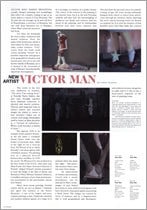
NEW ARTIST
VICTOR MAN
BY SIMON WATSON
VICTOR MAN MAKES BROODING, socially charged paintings and assemblages that reflect his complex coming of age as an artist, and as a citizen of Cluj, Romania. The 33-year-old was brought up in and still lives in Transylvania, a province of Romania, but one with deep historical ties to Hungary, where Man's maternal ancestors hail from.
For Man, his homeland has been a place of physical and mental isolation. Even the name of his hometown, which is surrounded by hills and mountains, evokes isolation: "Cluj" comes from the Latin word clusum, meaning "closed." As a possible long-term consequence of its geographical situation and ancient past, the city is not well known outside of Romania, yet it is situated at the crossroads of some of Europe's most historically important thoroughfares.
The works in his first solo exhibition in London, "The place I'm coming from," at Timothy Taylor Gallery this past year, brought together those disparate references to physical and mental isolation. Obscure and tangential links in subject matter and recycled images are joined to create a new narrative. Taken out of context, each image reformulates itself to create, as Man describes it, a "terrain of turbulence. Where truth becomes a matter of clues."
His diptych 1939 is an example of this narrative friction: in the left panel a costumed female Santa walks over the bodies of prostrate men, while in the right we see a close-up from The Wizard of Oz in which Dorothy's red shoes glitter with a fetishistic menace. The painting acts as a physical face-off between East and West. In 1939 the movie The Wizard of Oz was produced in the free world of the U.S.A.; that same year Hans Frank (the Nazis' Governor-General of Poland) obliged Poland's Jewish population to wear the badge of the Star of David, and Romania's Prime Minister Armand Calinescu, a steadfast adversary of pro-Nazi movements, was assassinated by the anti-Semitic, fascist Iron Guard.
Man's most recent painting, Untitled (which will be on view at Johnen + Schöttle and again this summer at the Venice Biennale), is one of his largest and most complex paintings to date. Ominously costumed and masked children appear on a stage, as if in a nostalgic re-creation of a gothic dream. The source of the tension in the painting is not entirely clear, but it is rife with Freudian symbols and ripe with the intermingling of predatory sex, death, and violence. And the mood of the painting, and its relationships between very dark tones, captures that moment when day slides into night - that particular moment when colors run away from things.
An undercurrent of violence and eroticism, viewed with a steady detachment, can be detected in Man's works: images of men buried face-down in snow, dark-hooded figures with faces obscured, deep-green glades puncturing a black forest. The images are scarred by traces of memory, and by a fragmentation that is both geographical and ideological.
One also finds the personal traces of a painful coming of age, the artist having awkwardly bumped from school to school from adolescence through his twenties, always exploring but never exactly knowing where his destiny as a painter lay. It is with the memory of that heartfelt quest that Man finds this cultural and political moment altogether too glib, and it is why he has a deep-seated suspicion of the state of painting today.
